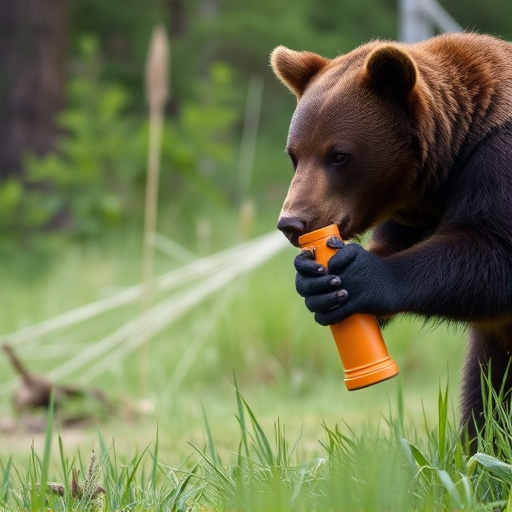Bear spray, a popular bear deterrent, undergoes natural decomposition over time, reducing its potency and requiring regular replenishment. Improper disposal of chemical components like capsaicin can cause environmental harm, affecting aquatic ecosystems and local biodiversity. Understanding the degradation rates influenced by temperature, humidity, and sunlight is crucial for users to replace bear spray at optimal times. The Environmental Effects of Bear Spray Decomposition highlight the need for sustainable alternatives using natural ingredients and advancements in formulation technology to minimize ecological disruption while maintaining effectiveness.
Bear spray is often hailed as a primary defense against aggressive bears, but its maximum stopping power and environmental effects remain under-examined. This article delves into the composition and active ingredients of bear spray, exploring their decomposition rates in outdoor settings and potential ecological impacts beyond target species. We also discuss sustainable alternatives and future developments in bear deterrents, shedding light on the broader environmental effects of common bear spray components.
- Understanding Bear Spray Composition and Active Ingredients
- Environmental Impact of Common Bear Spray Components
- Decomposition Rates and Longevity in Outdoor Settings
- Effects on Ecosystems and Wildlife Beyond Target Species
- Sustainable Alternatives and Future Developments in Bear Deterrents
Understanding Bear Spray Composition and Active Ingredients
Bear spray, also known as bear repellent, is a powerful defense mechanism designed to deter aggressive bears. Understanding its composition and active ingredients is crucial in maximizing its stopping power. The key components typically include capsaicin, a compound derived from chili peppers, and various other chemical agents. These substances create an unpleasant sensory experience for the bear, triggering a reaction that allows the potential victim to escape.
The Environmental Effects of Bear Spray Decomposition play a significant role in its overall effectiveness. As the spray breaks down naturally over time, the active ingredients eventually lose potency. This is why regular replenishment is essential to ensure the spray remains a reliable defense mechanism. Proper disposal methods are also important to minimize environmental impact, ensuring that the spray’s components do not harm wildlife or ecosystems when discarded incorrectly.
Environmental Impact of Common Bear Spray Components
Bear spray, a popular defense mechanism for outdoor enthusiasts and survivalists, contains chemical components designed to incapacitate bears temporarily. However, the environmental impact of these sprays, particularly their decomposition, is an area of growing concern. The active ingredients in bear spray, such as capsaicin or oleoresin capsicum, are derived from chili peppers and can have significant ecological consequences when not disposed of properly.
When bear spray comes into contact with water sources or soil, it undergoes a process of degradation. This decomposition can release harmful byproducts that may affect aquatic life and wildlife habitats. The environmental effects of bear spray decomposition include water pollution, as the chemicals can disrupt aquatic ecosystems, and soil contamination, which could impact plant growth and local biodiversity. Understanding these impacts is crucial for promoting responsible usage and disposal of bear spray to minimize its ecological footprint.
Decomposition Rates and Longevity in Outdoor Settings
The environmental effects of bear spray decomposition are an essential consideration in outdoor settings. Unlike conventional aerosol sprays, bear spray is designed to break down naturally over time, leaving no harmful residues. However, this breakdown process varies based on several factors, including temperature, humidity, and exposure to sunlight. In general, the degradation rate of bear spray is relatively quick, with most active ingredients losing their effectiveness within a few months to a year under optimal conditions.
In outdoor environments, where exposure to elements is inevitable, the longevity of bear spray can be significantly reduced. High temperatures, especially in arid regions, can accelerate the decomposition process, while moisture and sunlight can also play a role. Understanding these decomposition rates is crucial for users to make informed decisions about when to replace their bear spray, ensuring its maximum stopping power during potential encounters with bears in wild environments.
Effects on Ecosystems and Wildlife Beyond Target Species
Bear spray, while an effective self-defense tool against bear attacks, has far-reaching environmental implications that often go unnoticed. When used, the spray breaks down into various chemical components over time, which can have significant effects on ecosystems and wildlife beyond the intended target species.
The decomposition process of bear spray in the environment releases toxic substances, including capsaicin and other chemicals, which can contaminate soil, water bodies, and vegetation. These toxins may harm non-target animals like birds, fish, and small mammals, affecting their health and populations. Additionally, the long-term presence of spray residues in ecosystems could disrupt food chains and ecological balance, with unforeseen consequences for overall biodiversity. The Environmental Effects of Bear Spray Decomposition are a critical aspect to consider when evaluating its role as a defense mechanism in wild spaces.
Sustainable Alternatives and Future Developments in Bear Deterrents
The future of bear deterrents lies in finding a balance between effectiveness and minimal environmental impact. Traditional bear spray, while powerful, has significant environmental effects due to its chemical composition and rapid decomposition. This raises concerns about long-term ecological balance, especially in sensitive ecosystems.
Sustainable alternatives are being explored, focusing on natural ingredients with proven deterrents properties. Research into plant-based solutions, like specific essential oils and herbs, aims to develop eco-friendly options that effectively protect both humans and wildlife. Additionally, advancements in formulation technology promise improved spray performance and reduced environmental degradation, making them viable for widespread adoption without compromising conservation efforts.
The effectiveness of bear spray as a defense mechanism is undeniable, but understanding its environmental impact is crucial for responsible usage. The decomposition rates of bear spray components vary, with some ingredients having longer-lasting effects on outdoor settings and ecosystems. While these sprays can deter bears, they may also harm non-target species and disrupt delicate ecological balances. Exploring sustainable alternatives and developing environmentally friendly deterrents is essential to mitigate the potential long-term consequences of using bear spray. By considering both its maximum stopping power and environmental effects, individuals can make informed choices to ensure the safety of both humans and wildlife in bear country.
